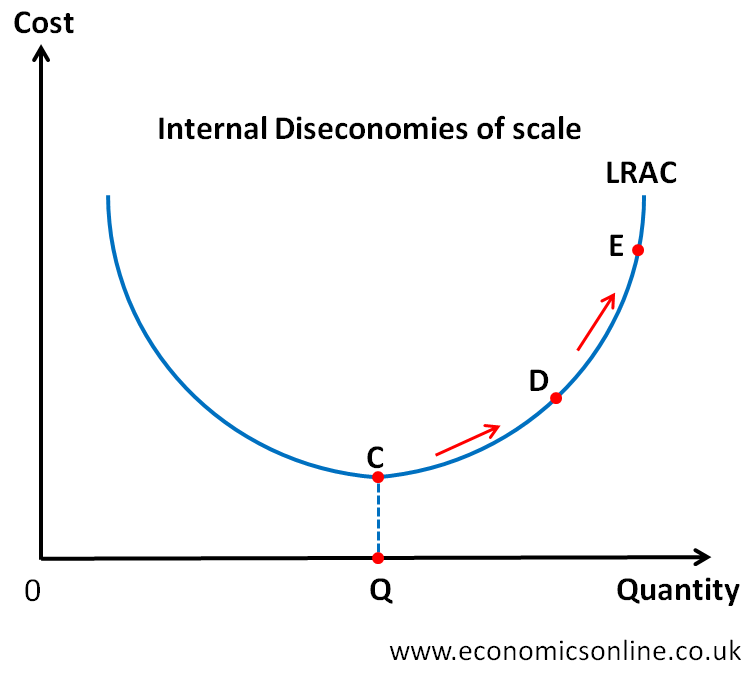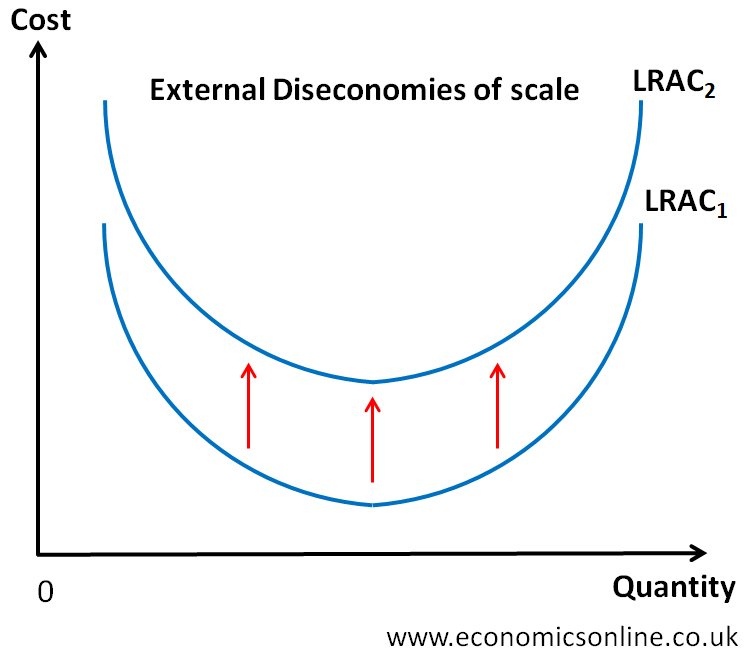
Diseconomies of Scale
An increase in the long run average cost (LRAC) because of an increase in the scale of operations of a firm after certain level is called diseconomies of scale.
On the other side the term economies of scale means a decrease in the long run average cost (LRAC) because of an increase in the scale of operations of a firm.
Economic theory predicts that a firm may become less efficient if it becomes too large. When firms become very large (expand its scale too much) they face an increase in its long run average cost of production, which is called diseconomies of scale.
There are two types of diseconomies of scale.
- Internal Diseconomies of Scale
- External Diseconomies of Scale
1. Internal Diseconomies of scale
An increase in LRAC because of an increase in the scale of operations of a firm after certain level independently of what is happening to other firms in the industry is called internal diseconomies of scale.

The internal diseconomies of scale arise simply from an increase in the scale of the production process in the firm itself. A firm grows and its output increases too much, it faces internal diseconomies of scale.
In internal diseconomies of scale, there is an upward movement from point C to point E along LRAC curve due to decreasing returns to scale as shown in the diagram.
Internal diseconomies of scale result in rising long run average costs which are experienced when a firm's production increases beyond its optimum scale, at Q.
2. External Diseconomies of scale
An increase in LRAC because of an increase in the size of industry (growth of industry) independently of what is happening to the firm is called external diseconomies of scale.
The external diseconomies of scale arise when long run average unit cost is increased, not due to any of the firm's actions, but because of growth of industry.
The external diseconomies of scale are faced by all the firms in the industry independently of the changes in the scales of their individual outputs. All firms in the industry, whether they are seeking to expand or not, may suffer rising costs as a result of the industry getting too large too quickly.
In external diseconomies of scale, there is an upward shift of LRAC curve due to the growth of industry.

Examples of Internal Diseconomies of Scale
1. Communication Problems
Larger firms often suffer from poor communication because they find it difficult to maintain an effective flow of information between departments, divisions, or between the head office and subsidiaries. An increase in the number of employees resulted in an increase in the number of communication channels. Time lags in the flow of information can also create problems in terms of less feedback and a slower response to changing market conditions. For example, a large supermarket chain may be less responsive to changing tastes and fashions than a much smaller, ‘local’ retailer.
2. Coordination Problems
Coordination problems also affect large firms with many departments and divisions, and may find it much harder to coordinate their operations than a smaller firm. For example, a small manufacturer can more easily coordinate the activities of its small number of staff than a large manufacturer employing tens of thousands of workers.
3. Alienation of Workers
The bigger the firm, the more difficult it may be to directly involve every worker and to give them a sense of purpose and achievement in their work due to the large workforce. This happens due to the overcrowding of workers. They may feel so insignificant to the overall business plan that they become demotivated and fail to give their best. Low motivation of workers in large firms is a potential diseconomy of scale that results in lower productivity, as measured by output per worker. This lack of motivation among workers will eventually result in higher unit cost. Lower employee motivation can also lead to higher labour turnover in firms.
4. X Inefficiency
‘X’ inefficiency is the loss of management efficiency that occurs when firms become large and operate in uncompetitive markets. Such loss of efficiency includes over paying for resources, such as paying managers salaries higher than what is needed to secure their services, and excessive waste of resources. ‘X’ inefficiency means that average costs are higher than what would be experienced by firms in more competitive markets.
5. Principal Agent Problem
Large firms may experience inefficiencies related to the principal-agent problem. This problem is caused because the size and complexity of most of the large firms which means that their owners often have to delegate decision making to appointed managers, which can lead to inefficiencies. For example, the owners of a large chain of clothes retailers will have to employ managers for each store, and delegate some of the jobs to managers but they may not necessarily make decisions in the best interest of the owners. For example, a store manager may employ the most attractive sales assistant rather than the most productive one.
Examples of External Diseconomies of Scale
1. Shortage of Labour
Growth of the industry may lead to a shortage of labour with the appropriate skills. Firms may have to bid higher wages to attract more workers. This will increase labour cost.
2. Increased Prices of Inputs
Increasing demand for inputs such as raw materials may also lead to higher prices of inputs resulting in higher costs for firms. Another example can be of a highly localised industry. Land for expansion may become scarce and it will be more expensive to purchase or rent leading to higher costs for firms.
3. Infrastructure
Diseconomies of infrastructure occur when an industry becomes so large that it starts to negatively impact the infrastructure in the local area. For example, an increase in traffic congestion or a decrease in transportation efficiency due to overuse of roads or trains. This can happen in certain industries such as freight, taxi and retail. For example, when it takes longer to deliver goods to a store, it increases the overall cost of the final product.
3. Increased Transportation Cost
Transport costs may also rise because of increased congestion.
Conclusion
Diseconomies of scale are the increase in LRAC due to an increase of the scale of operations of a single firm (internal diseconomies) or due to the growth of industry (external diseconomies). In case of internal diseconomies of scale, there is an upward movement along LRAC curve while in external diseconomies of scale; there is an upward shift of LRAC curve.


